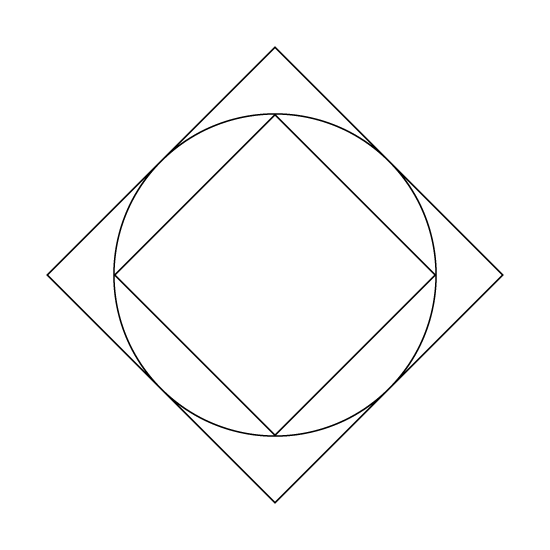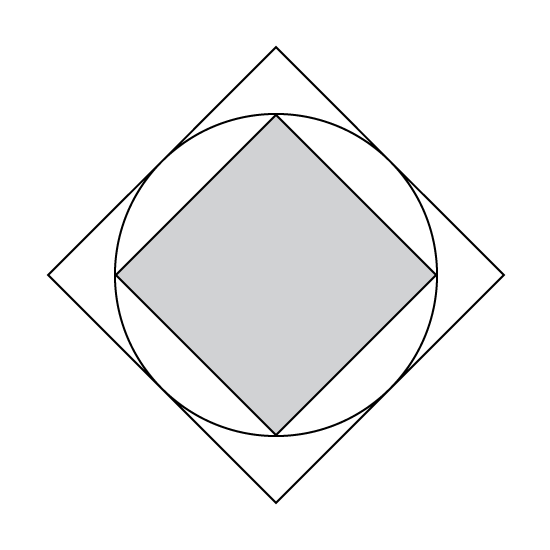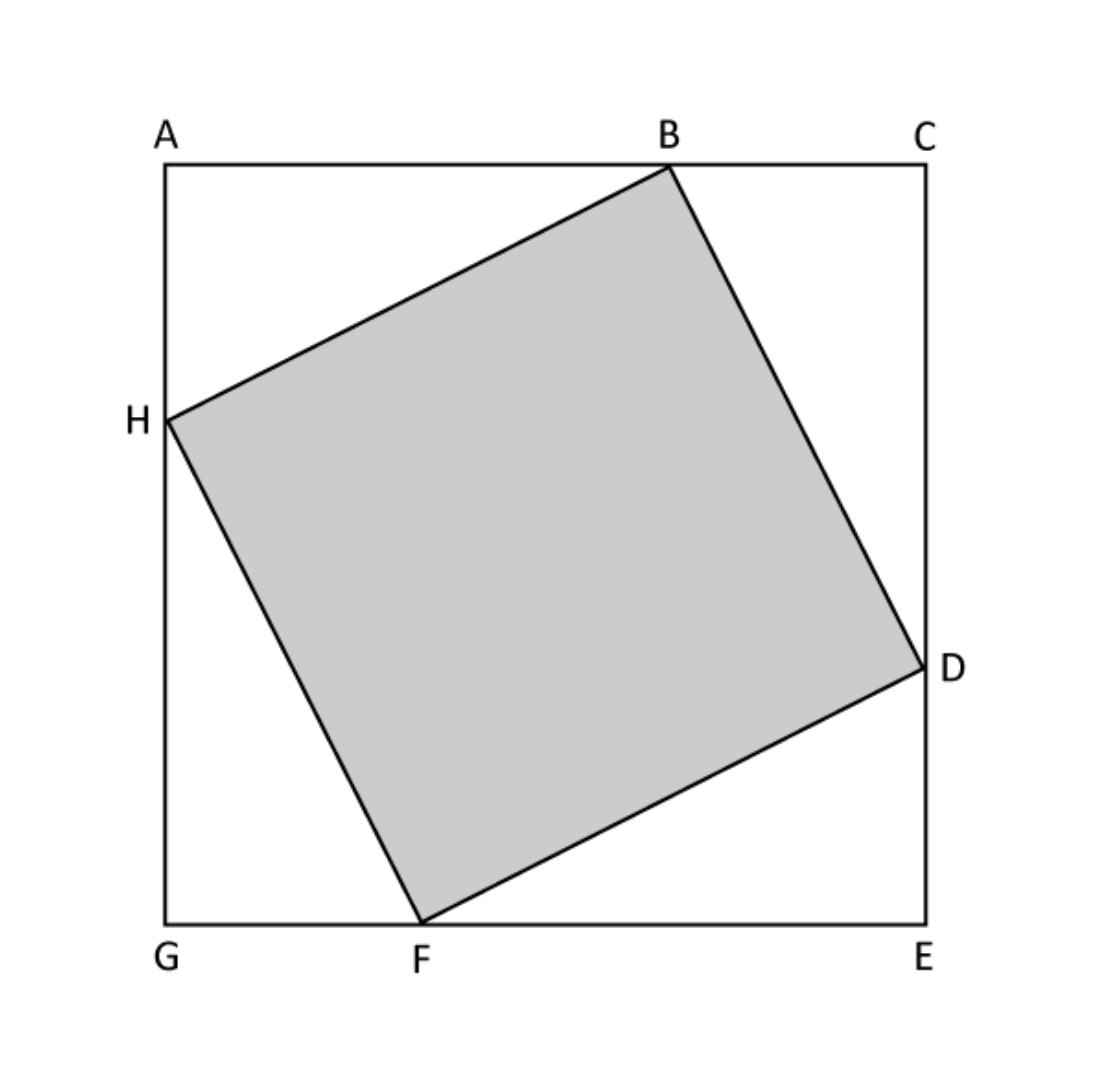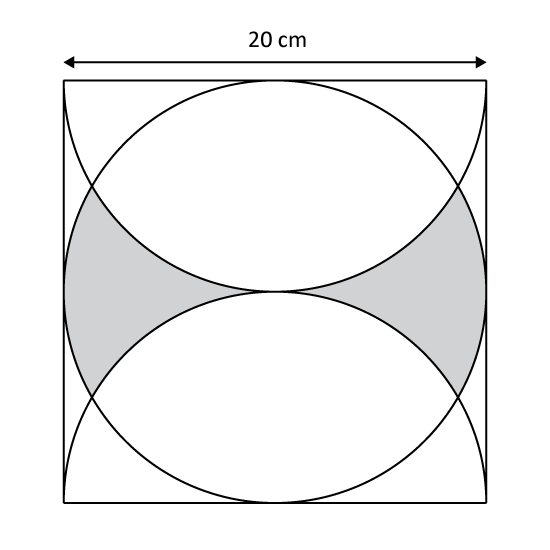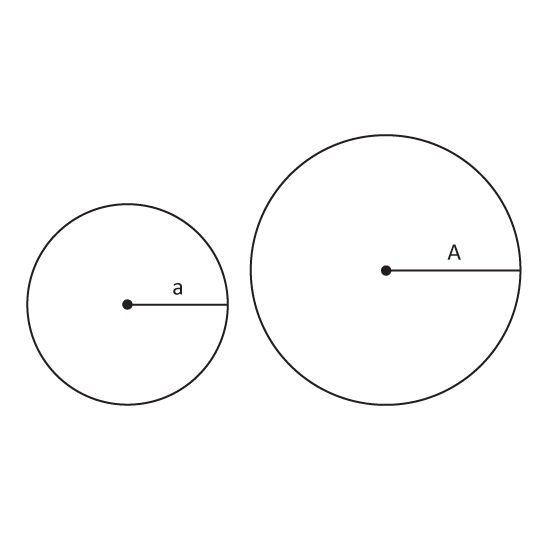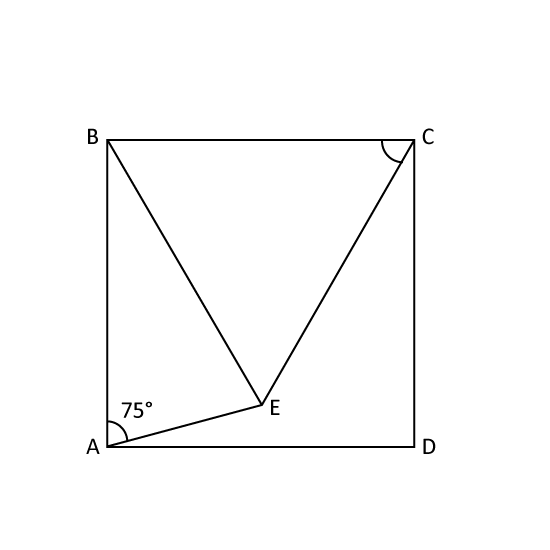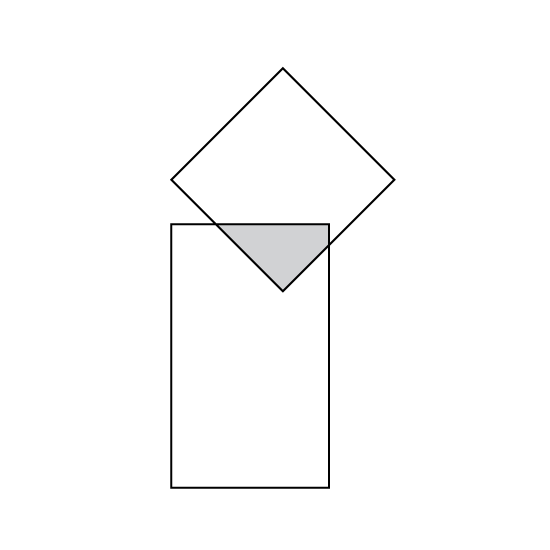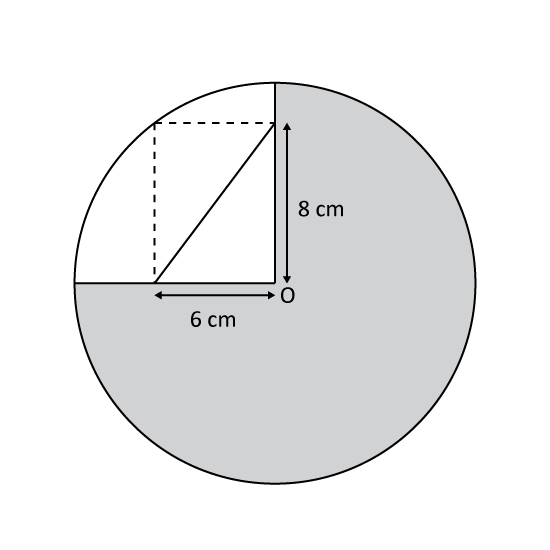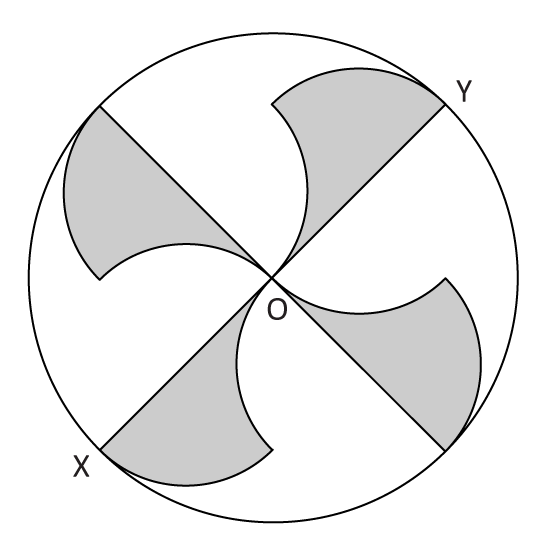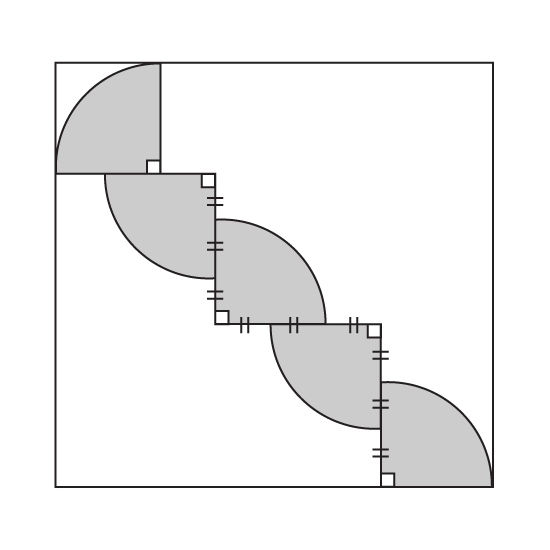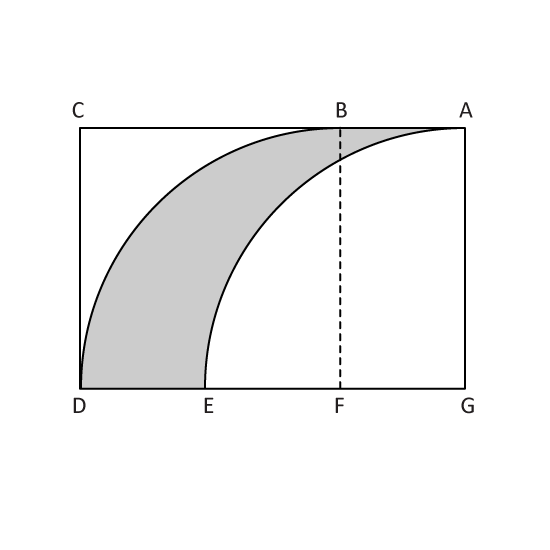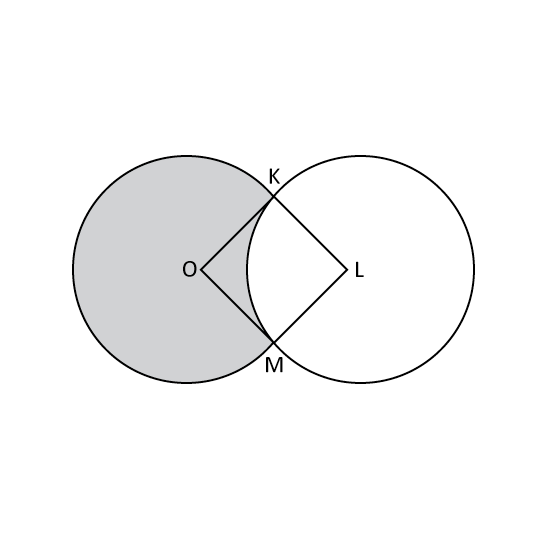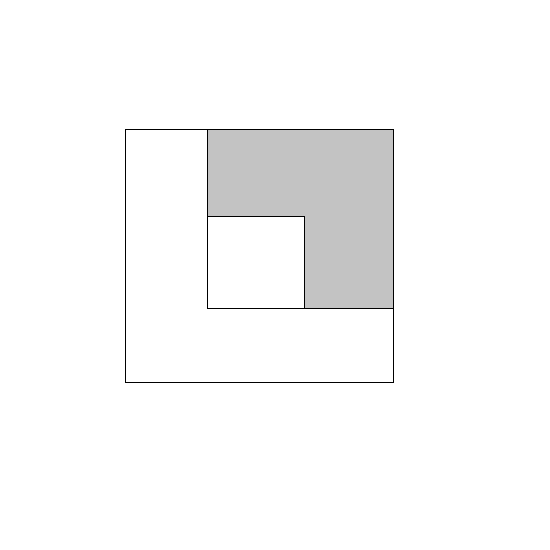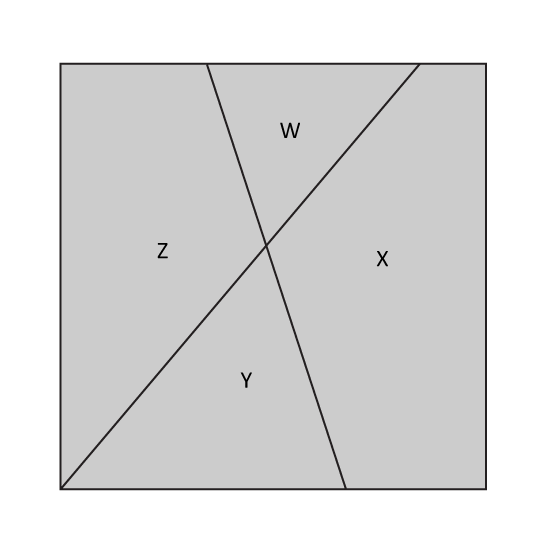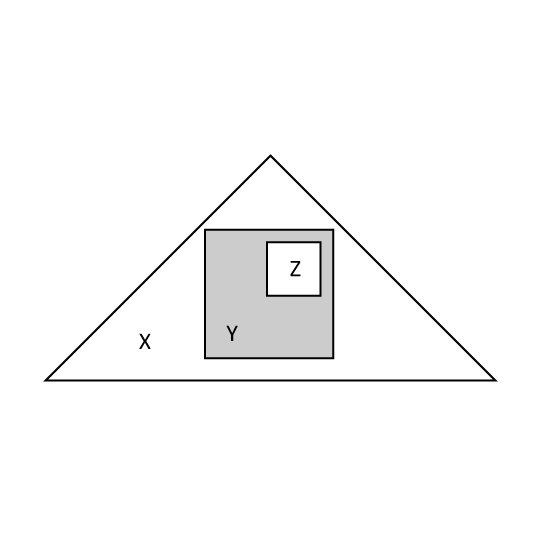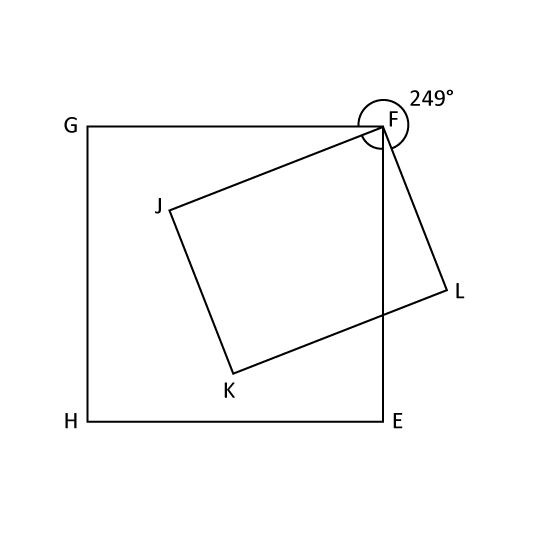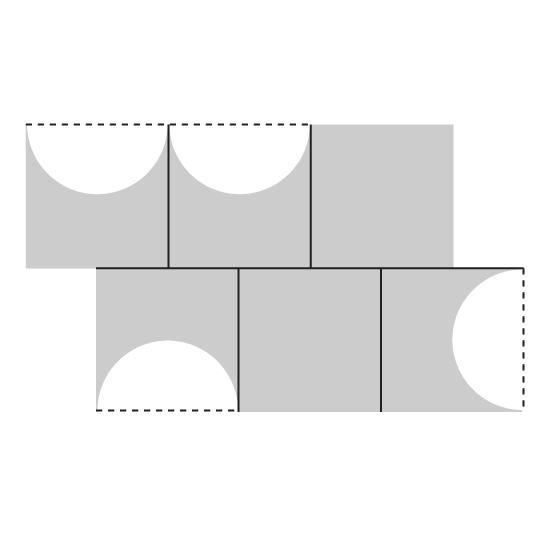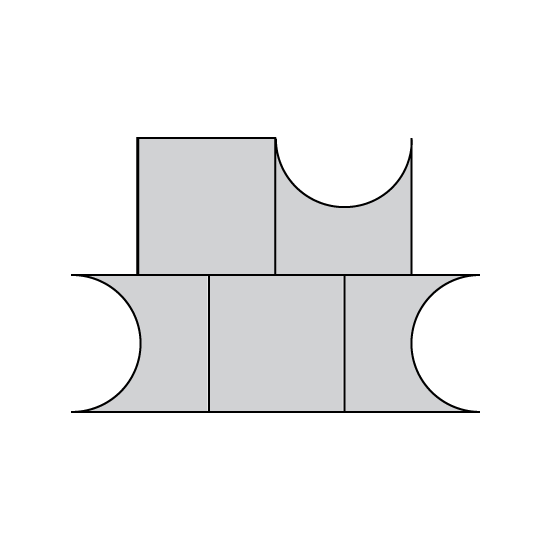Level 2
In the figure, the circle is touching each of the two squares at exactly four points, if the area of the bigger square is 100 cm2, find the area of the smaller square.
Level 2
In the figure, the circle is touching each of the two squares at exactly four points, if the area of the bigger square is 100 cm2, find the area of the smaller square.
Image in this question is not available.
Level 2
The figure consists of 2 squares and a circle. If the length of the bigger square is 10 cm, what is the area of the shaded part?
Level 2
The figure consists of 2 squares and a circle. If the length of the bigger square is 10 cm, what is the area of the shaded part?
Image in this question is not available.
Level 3 PSLE
In the figure not drawn to scale, ACEG and BDFH are squares. AB, CD, EF and GH are of the same length. The ratio of AB : BC is 3 : 1.
- What fraction of square ACEG is shaded?
- If the length of the square is 96 cm, find the unshaded area in cm2.
Level 3 PSLE
In the figure not drawn to scale, ACEG and BDFH are squares. AB, CD, EF and GH are of the same length. The ratio of AB : BC is 3 : 1.
- What fraction of square ACEG is shaded?
- If the length of the square is 96 cm, find the unshaded area in cm2.
Image in this question is not available.
Level 2
Find the perimeter of the shaded parts. (Take π = 3.14)
Level 2
Find the perimeter of the shaded parts. (Take π = 3.14)
Image in this question is not available.
Level 2
The circles are not drawn to scale. The small circle is with radius a and the big circle is with radius A. The ratio of a to A is 4 : 7. If the area of the small circle is 169π cm2, find A. Express the answer in mixed number.
Level 2
The circles are not drawn to scale. The small circle is with radius a and the big circle is with radius A. The ratio of a to A is 4 : 7. If the area of the small circle is 169π cm2, find A. Express the answer in mixed number.
Image in this question is not available.
Level 2 PSLE
In the figure ABCD is a square, AB = BE and ∠BAE = 75°. Find ∠BCE.
Level 2 PSLE
In the figure ABCD is a square, AB = BE and ∠BAE = 75°. Find ∠BCE.
Image in this question is not available.
Level 2
The figure is made up of a rectangle and a square. 79 of the square is unshaded and 16 of the rectangle is shaded. What fraction of the figure is shaded?
Level 2
The figure is made up of a rectangle and a square. 79 of the square is unshaded and 16 of the rectangle is shaded. What fraction of the figure is shaded?
Image in this question is not available.
Level 2
A rectangle is placed in a circle with O as the centre. Use the calculator value of π to find the shaded part of the circle. Correct the answer to 1 decimal place.
Level 2
A rectangle is placed in a circle with O as the centre. Use the calculator value of π to find the shaded part of the circle. Correct the answer to 1 decimal place.
Image in this question is not available.
Level 2
The figure shows a circle. O is the centre and the diameter XOY is 42 cm long. Each of the shaded part is formed by the radius of the big circle and 2 identical quarter arcs. Find the total area of the shaded parts in the figure. (Take π = 227)
Level 2
The figure shows a circle. O is the centre and the diameter XOY is 42 cm long. Each of the shaded part is formed by the radius of the big circle and 2 identical quarter arcs. Find the total area of the shaded parts in the figure. (Take π = 227)
Image in this question is not available.
Level 2
5 identical quarter circles were cut out from a square cardboard of length 18 cm. Find the area of the 5 quarter circles. Leave the answer in terms of π.
Level 2
5 identical quarter circles were cut out from a square cardboard of length 18 cm. Find the area of the 5 quarter circles. Leave the answer in terms of π.
Image in this question is not available.
Level 2
The figure, not drawn to scale, consists of a rectangle ABFG, a square BCDF, and 2 identical quadrants AGE and BFD. AG = 8 cm and FG = 4 cm. Find the shaded area. (Take π = 227)
Level 2
The figure, not drawn to scale, consists of a rectangle ABFG, a square BCDF, and 2 identical quadrants AGE and BFD. AG = 8 cm and FG = 4 cm. Find the shaded area. (Take π = 227)
Image in this question is not available.
Level 2
The figure is made up of 2 identical circles with centres O and L. OKLM is a square of sides 10 cm. Find the area of the shaded part.
Level 2
The figure is made up of 2 identical circles with centres O and L. OKLM is a square of sides 10 cm. Find the area of the shaded part.
Image in this question is not available.
Level 2
W, X, Y and Z are mid-points of the sides of the square. If the area of the square is 100 cm2, what is the area of the unshaded triangles? Leave your answer in mixed number.
Level 2
W, X, Y and Z are mid-points of the sides of the square. If the area of the square is 100 cm2, what is the area of the unshaded triangles? Leave your answer in mixed number.
Image in this question is not available.
Level 3
This figure is not drawn to scale. It is made up of 3 squares. The ratio of the area of the smallest square to the largest square is 2 : 9 while the shaded area is 37 of the unshaded area. What is the ratio of the shaded area to the area of the smallest square?
Level 3
This figure is not drawn to scale. It is made up of 3 squares. The ratio of the area of the smallest square to the largest square is 2 : 9 while the shaded area is 37 of the unshaded area. What is the ratio of the shaded area to the area of the smallest square?
Image in this question is not available.
Level 3
The square is divided into 4 parts, W, X, Y and Z. W and X form 12 of the square. The area of Y is double of the area of Z, while the ratio of the area of X to the area of W is 1 : 3.
What fraction of the square is the sum of the area of X and Y? Leave the answer(s) in the simplest form.
Level 3
The square is divided into 4 parts, W, X, Y and Z. W and X form 12 of the square. The area of Y is double of the area of Z, while the ratio of the area of X to the area of W is 1 : 3.
What fraction of the square is the sum of the area of X and Y? Leave the answer(s) in the simplest form.
Image in this question is not available.
Level 3
The figure is made up of two squares and a triangle. The ratio of the area of Triangle X to that of Square Z is 11 : 1. The ratio of the shaded area to that of the unshaded area is 1 : 3. If the difference between areas of Triangle X and Square Y is 464 cm2, what is the area of Square Z?
Level 3
The figure is made up of two squares and a triangle. The ratio of the area of Triangle X to that of Square Z is 11 : 1. The ratio of the shaded area to that of the unshaded area is 1 : 3. If the difference between areas of Triangle X and Square Y is 464 cm2, what is the area of Square Z?
Image in this question is not available.
Level 2 PSLE
The shaded figure is formed using 3 squares and 3 equilateral triangles. The length of the straight line PQ is 15 cm. Find the perimeter of the shaded figure.
Level 2 PSLE
The shaded figure is formed using 3 squares and 3 equilateral triangles. The length of the straight line PQ is 15 cm. Find the perimeter of the shaded figure.
Image in this question is not available.
Level 2 PSLE
In the figure, EFGH is a square, FJKL is a rectangle and ∠GFL = 249°. Find ∠ EFJ.
Level 2 PSLE
In the figure, EFGH is a square, FJKL is a rectangle and ∠GFL = 249°. Find ∠ EFJ.
Image in this question is not available.
Level 2
The figure is formed by 6 identical squares with 4 similar semi-circles cut out from it. Each square has a side of 14 cm. Find the perimeter of the shaded figure. Express the answer in terms of π.
Level 2
The figure is formed by 6 identical squares with 4 similar semi-circles cut out from it. Each square has a side of 14 cm. Find the perimeter of the shaded figure. Express the answer in terms of π.
Image in this question is not available.
Level 2
The figure is formed by 5 identical squares with 3 similar semi-circles cut out from it. Each square has a side of 14 cm. Find the perimeter of the shaded figure. Leave the answer in terms of π.
Level 2
The figure is formed by 5 identical squares with 3 similar semi-circles cut out from it. Each square has a side of 14 cm. Find the perimeter of the shaded figure. Leave the answer in terms of π.
Image in this question is not available.
